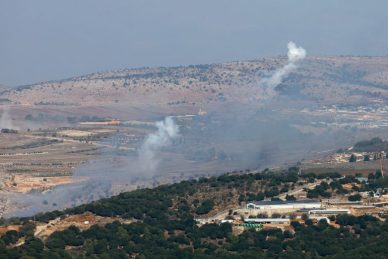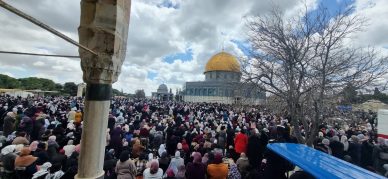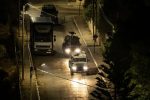The first photograph in the Arab world was taken on October 1839 three months after the invention of photography had been announced by Franceou Argo the chief of the French Republican Party who bought this invention from the inventor Dagier and presented it to Mankind. Argo emphasized that the new invention “will have the credit of recording the wonders of the East and it will contribute in developing archaeology which [at present] needs several specialists and a long time to draw and copy millions of pictures and hieroglyphics whereas one photographer can accomplish the same thing now.” Since the first picture was taken in Alexandria the Arab world has achieved photographic documentation. Hundreds of photographers went to Syria and Egypt to take pictures for the ancient temples cities models geometric figures and landscapes which were welcomed in Europe; some historians even considered them as pictures from outer space.
The first photograph from Alexandria was taken by the French photographer Fredrick Gobiel Feisky who visited Egypt and Syria with the French painter Horas Verniet. He described the moment he was able to persuade Mohammed Ali Basha that the Dagierotape machine could take pictures of most scenes when he said “Mohammed Ali was quite interested and worried especially when he got into the darkened room so I could put the plates in the mercury so all of us were silent and worried and none dared to move.
The matchstick was ignited and the bronze faces were well seen except for Mohammed Ali’s face. He was standing near the machine frowning and sneezing but this was his habit when he got surprised. Getting impatient he turned back and shouted: ‘This is a diabolic act!’ then he left the room grabbing his sword which he did not ever leave without as if he were expecting a secret conspiracy or a mystery.” The first French photography campaign moved from Alexandria to Syria passing through Al:areesh Gaza Hebron and Jerusalem where they took several pictures and presented them in a book published in Paris in 1841. More than 300 photographers were active in Syria and Egypt; most of them were French British German and American. The most prominent one was Joseph Dobrangy the specialist in Islamic architecture who took several rare pictures of Jerusalem in1844. In the same year Alexander Keith a British photographer took about 30 pictures using the Dagierotape in order to find out the relationship between these places and what had been stated in the Bible. Some of these were presented in his book “Proofs on the Reality of Christianity” which included 18 pictures and was printed in London six times.
In 1849 Klaud Boss Welhouse a British photographer took the first picture on paper of the Mediterranean and part of Jerusalem. He took 90 rare pictures in Portugal Egypt Syria and Greece but the film was burned in the fire of London in 1879. However one copy was preserved by the Royal Society of Photography in Path.
The first resident photographer in Jerusalem was James Gaham a secretary of a British society to Christianize the Jews in Jerusalem and Palestine. He opened the first studio in Jerusalem in the 1850s and took a lot of pictures in Syria and Palestine. A French group including the photographer Maxim Duncamp and the writer Gustav Flopaire arrived in Jerusalem and took 12 pictures for the city and presented them in a special book in Paris in 1852. Other interested persons such as the bishops Albert Isaac and George Bridges and the photographer Peter Burghaim took several pictures of Jerusalem Jaffa and the coastal regions as well as Damascus and Ba’labak.
The most prominent British photographer during the period 1859-1860 was Francis Freeth who made three journeys to Egypt and Syria and took some pictures. He then issued some picture books which were welcomed by the British especially the Victorians. These books included detailed accounts of the places he visited from a chauvinistic point of view in an attempt to imitate David Roberts and the British formal views as expressed by the British politicians such as Melner and Kersen. Freeth chose Egypt and Syria because they were the most important areas on the globe at that time as he mentioned in his book “Egypt and Syria” recognizing the religious historical and commercial significance of the region for the British. He said he did so to amuse the audience by presenting the wonders of the East. Recognizing the positive reaction of the audience and the profitability of this business he made a third visit to the region in 1860 after he had visited it twice in September and October of 1856. His corporation presented thousands of pictures of Egypt and Syria during the second half of the 19th century. These pictures were used in various handbooks concerning the area when Freeth himself showed the historical significance of those pictures in the introduction of his book saying “The photographs are very important because the ruins have been changed by the weather the people who visit them and the peasants. The ruins are predated by those people who take the beautiful stone pieces to their homeland.”
He went to Egypt and Syria after the Suez Canal had been opened which made the British concentrate on Cairo more than Istanbul and so Egypt passed through radical changes and Western customs spread because Sa’eed Basha had been educated in the West as Freeth mentioned in his book. The French photographer August Salsman was sent by the French Ministry of Education to Jerusalem in 1855 to take about 174 pictures which he presented at the Paris First Exhibition of Photography in 1856. He was granted a golden award for his panoramic shots of Jerusalem; other photographers took part such as Duclark and Ouline. Duclark was sent by the French Ministry of Orientation to carry out some photographic studies in Syria. He published four books entitled “A Journey to the East”; one of them deals with Jerusalem but the pictures were quite identical to those taken by Salsman. Most of the pictures of Jerusalem were taken by the Bonefes corporation owned by Felix and his son Adrian Bonefes whose family went to Lebanon in 1867 and established a studio in Beirut. They took more than 1500 pictures of Palestine Syria Lebanon Turkey and Greece. He marketed those pictures extensively during the 1860s through 1910 whereafter he opened branches in Cairo Damascus and Jerusalem. Moreover the British Crown Prince Edward’s visit to the region in 1862 marked the outset of the Oriental studies when the photographer Bedford who was quite close to the Royal family took about 172 pictures and presented them in an exhibition supported by the Royal family in London.
The British strategic concern with the Holy Land began in the 1860s by surveying the area and getting more information about it. A team belonging to the engineering department in the British army led by Wilson visited Jerusalem in 1860 to take pictures and draw charts. This survey increased the European interest in Jerusalem and several expeditions went to the region. One such expedition was the “Palestine Survey Fund” established in 1865 and its members were all military people who prepared the charts and maps. The announced purpose of the expedition was to explore the past of the area in all aspects especially the Sinai Peninsula to trace the Jewish sites and paths during the Exodus. The project began in the winter of 1868 and was completed in 1869. The pictures of the tribes the animals the flowers and the geography were presented in three volumes.
The team was led by Palmer under the supervision of the British Ministry of War. Meanwhile the British Navy officers were surveying the coastal region from Al:areesh to Eskandaron north. Thousands of pictures were taken during the British intensive survey campaigns in the second half of the previous century. These pictures have been preserved in the archives of the “Palestine Survey Fund” in London and they are the rarest collection about the region because they include pictures of cities towns temples and excavations. The Palestine Survey Fund had enriched the knowledge base of the British about the region because those charts and maps that had been taken under the pretext of the exploration of the past were used later by General Allenby when he attacked the Turks and conquered Jerusalem during the First World War in 1918. Consequently the actual reasons behind this became obvious: to develop Palestine and to enable the Jews to do so. Those pictures were valuable although the photographers focused on the folklore and anthropological aspects for marketing purposes in the West. Thus it is impossible to separate the process of taking these pictures and the strategic situation in the region as well as the imperial competition especially between the British and the French who were quarrelling over the legacy of the Turkish empire.
Napoleon’s expedition to Syria and Egypt in 1798 was the beginning of this ideological competition and imperialism as expressed by the French writer Victor Hugo in his book “Les Orientals” published in Paris in 1829. Thereafter hundreds of photographers scientists anthropologists painters military people and politicians went to the region under the pretext of scientific expeditions supported by the European and American universities and centres. As a result several Arab countries were occupied by France such as Algeria in 1830 Tunis in 1881 Morocco in 1907 and Lebanon in 1860; others were occupied by Britain such as Cyprus in 1830 Egypt in 1882 and Eden and Yemen after the Suez Canal had been opened in 1869. Because of this imperial competition photography was developed and used for criticism especially the pictures and paintings by the Western artists supported by the European ideological institutions in particular the romantic side which influenced the Orientalist painters to take more photographs and 30 years later more pictures were taken reflecting the superiority of the West.
There are other factors behind the development of photography such as the use of cargo and passenger ships in 1840 because a lot of tourists and pilgrims came to the Holy Land through the Marseille-Alexandria sea line to Jaffa and Beirut headed by Thomas Cook who announced several voyages to Egypt and Syria in 1868 in London. This movement of tourists and the development in photography made it easier and so several studios were opened in Jerusalem Cairo Beirut and Jaffa. As a result the photography industry moved from Europe to the region.
Finally the first school to teach photography was opened by the Armenian Bishop Yassai Grapedian in Jerusalem in the 1850s. Several professional photographers graduated from this school. Grapedian came to Jerusalem from Istanbul in 1844 to pursue his studies until 1859 when he did several experiments on photography at St. James Cathedral. Then he spent four months in Istanbul practising photography techniques and so he began his career in the late 1850s because some pictures were signed by him in 1860. He visited Manchester London and Paris in 1863 to find out more about photography techniques. Then he went back to Jerusalem in 1865 and was appointed a Patriarch but he continued his career in photography as shown in Baedecker’s Guide about Palestine in 1876: “There were several studios in Jerusalem and the Armenian Cathedral studio was one of them.”
The French traveler Jules Hosche (1884) showed that Yassai Grapedian taught photography when he says “Grapedian taught some Armenians photography in the Armenian Cathedral studio during the period 1865-1885 when photography prospered in Syria. Some of his students included Grapede Kefork Krekorian and Khaleel Ra’ad from Lebanon. Krekorian used to make portraits and signed them as “Photographer Jerusalem Armenian Church Krekorian.” The first photographs of the Arab region were quite rare and they are owned by the museums and institutions so they are extremely expensive and their price may increase to thousands of dollars because they are documentary. The most prominent photographer was Adrian Bonefes in Beirut who explained the significance of these pictures in his albums “Everything seems static in the East even the minute details because the region has not been changed although 20 centuries have already passed without any change in the features of the region but the new development and civilization will destroy the whole region and so it will lose its idiosyncrasy.”















